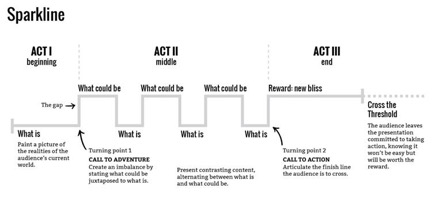For months you’ve been trying to get a meeting with an exciting new prospect. You’ve emailed. You’ve chatted on the phone. They seem interested, but never available. And then suddenly the stars align — they can see you tomorrow. Fantastic! Until you realize you now have less than 24 hours to put together the perfect sales pitch.
What are you going to do?
First things first — don’t panic. A sales pitch is just a story by another name — and we all tell stories all the time. You can do this.
Let’s start by writing a quick story outline. You have your hero (the prospect or someone the prospect can closely identify with). And your happy ending — the positive impact of investing in your product. Do you have your hero’s dilemma? Of course, you do — that’s the pain point you’re selling to.
Finding the Pain Point
Hopefully, overall these long months of trying to book this meeting, you’ve narrowed down what it is about this organization that qualifies it as a good prospect.
In the event you skipped this step, you’ll have to resort to generics. Does the company match your ideal buyer profile? (If it doesn’t, you’ve got to question why you wanted the meeting!) This profile should include an overview of probable pain points that will serve as your dilemma here.
For example, I sell a Sales Enablement platform, so generic pain points include:
- Salespeople can’t find the right resources at the right time
- Marketing is frustrated that salespeople aren’t using the right content
- Marketing has no idea how salespeople are using materials
- Salespeople are using print brochures instead of digital — heavy, expensive, harder to share with multiple people
If I were telling a story about our solution, these pain points would make up my dilemma.
Story Arc — AKA Your Slide Deck
Now that you have your hero and your hero’s dilemma, you can tell a simple story.
There are lots of ways to do this — some more compelling than others. But you only have 24 hours, so let’s keep it simple and give you just one option. This is Nancy Duarte’s Sparkline story structure for presentations:

Source: Presentation Guru (Bookmark this – it’s really worth a read. But not now. You need to get on with your presentation)
This image gives you a simple framework on which you can build your slide deck.
- What is = Pain point
- What could be = Impact of solution
You build these up, layer by layer, so the prospect understands both the immediate and broader impact of their current reality and that of their transformed reality with your solution. (Note: you’re talking about the impact, not the solution itself. Benefits, not features.)
Basic Presentation Structure
Based on this outline, if I was putting together a very last-minute presentation, I could do something like this:
- Dark picture of current reality. All of the pain points in one brief representative story. I would probably use either a real customer “before” story or a composite character based on several different customers.
- Happy picture of same customer/character having implemented the new solution, spelling out the differences in their reality compared with 1)
- Take one pain point — emphasize the impact this was having on the business
- Show the effect of solving this pain point
- As 3 but with a different pain point
- As 4 but with a different impact
- Final bleak picture of current scenario — save the most impactful for last
- Call to action — very brief overview of the solution
- Reward — the biggest and farthest-reaching effects of transitioning to the new solution
- Summary — it takes some work to achieve the reward, but it’s worth it. Reminder of big incentives for change.
Of course, the success of this slide deck depends on whether your exciting new prospect identifies with the characters and pain points in your story. This really depends on you having done your research, properly qualifying the lead, and understanding the impact your solution could have — something that might be harder to squeeze in at the last minute.
Be Better Prepared Next Time
One of the advantages of this simple structure is you could have these slides prepared to demonstrate every pain point your solution solves. Next time you book a meeting at short notice, you will already have the necessary materials to make a convincing sales pitch — and it will be easy to tailor to the prospect according to their individual challenges. You could even spend the first few minutes of the meeting talking with the customer to get a proper sense of their dilemmas and then use a Sales Enablement Tool to put the pitch together on the fly.
Don’t Panic
When you know your product, and you believe in the benefits it can bring to your ideal customers, you don’t need a fancy slide deck to be convincing. It helps to have something visual to back you up, and to jog your memory if you need it. But your prospect is most interested in what you have to say that can solve their problems.
Storytelling is the best way to engage your prospect’s emotions and capture their attention. If you start thinking in terms of stories instead of slides, you’ll likely find the whole process much less daunting — even if you are pitching on short notice!
About the Author: Charlotte Powell is the Head of Design and Marketing at iPresent, a sales enablement platform developed by experienced sales professionals. iPresent is tailor-made to give sales teams all the tools they need to create beautiful and effective sales presentations





Comments (3)
Awesome write. Good and practical to write an urgent sales pitch that can close.
Storytelling in Sales works and helps reach your audience. Great article, thanks for sharing!
Nice article I like it it has a clear objective and it covers what customers cares about.